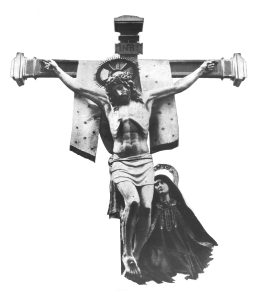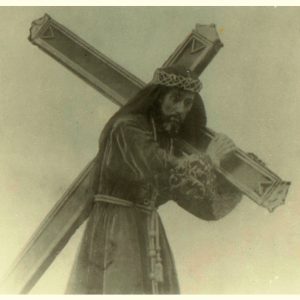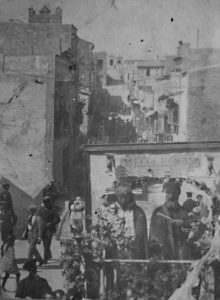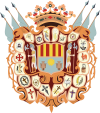THE HISTORY OF OUR HOLY WEEK
Although there is no certain proof of the origins of the Holy Week in Crevillent, it can be affirmed that shortly after the expulsion of the Moors the first brotherhoods were already constituted of which the brotherhood of the “Virgen de la Aurora” and the “Mayordomía del Santísimo Sacramento” (born in the first quarter of the XVII century) have arrived to the present day.
But there is no doubt that the transcendental fact for our Holy Week constituted it the donation that would make the Duke of Arcos, lord of the villa, in the year 1753 of the hill denominated Camposanto at that time, so that in it the Via Crucis was erected and the celebration of some processions was allowed to be able to make there the Encounter of the Virgin of Sorrows and the Holy Christ.
After several years of work in which the whole population participated, the Via Crucis was erected on February 5, 1768, remaining that date as one of the most important in the history of the Holy Week in Crevillent.
The second half of the 19th century represents the first moment of splendor for the Passion Celebration with the acquisition of an important number of images or processional groups, works by Antonio Riudavets or Francisco Pérez Figueroa, constituting the first guilds that had a cooperative or family character.
The tragic circumstances that occurred in 1936, which submerged Spain for three years in a fratricidal and anticlerical struggle, caused the burning and destruction of the processional images that remained for worship in the parish church of Our Lady of Bethlehem (XVIII-XIX century) and in the Hermitage of the Holy Trinity.
Crevillent lost in the civil war the processional images of Ecce Homo (popularly known as “Pas del Balcó” in valencian language), Christ of the Victory, Nazareno, Virgin of the Sorrows, Virgin of the Anguish, Virgin of Loneliness and the Reclining Christ.
However, thanks to the astuteness of the different families, the icons that guarded the different families were able to survive the excesses and contribute to the rebirth of the Holy Week in the decade of the forties of the last century.



The decade of the years 1940 represents the moment of greater brilliance of the Holy Week in Crevillent, with the acquisition of new icons to ennoble the processions; thus, thanks to the mediation of the Magro Espinosa family, the images made by Mariano Benlliure arrive to the population, next to others of famous sculptors of the moment such as Carmelo Vicent, Juan García Talens, Fina Cuesta, Antonio Parera, Navas Parejo, etc., being the Holy Week configured as it has arrived until the date.
That boom that was experiencing the Holy Week made necessary the creation of an agglutinating organism of all the Brotherhoods, that will act as visible head and representative of the same ones before any institution. It is thus when the Patronage of Holy Week is constituted, who, throughout the decades, would happen to be Municipal Commissions, Local Committee of Brotherhoods, Managing Committee, until in February of 1980 the legal text is approved that would give place to the present Federation of Brotherhoods of the Holy Week in Crevillent.

